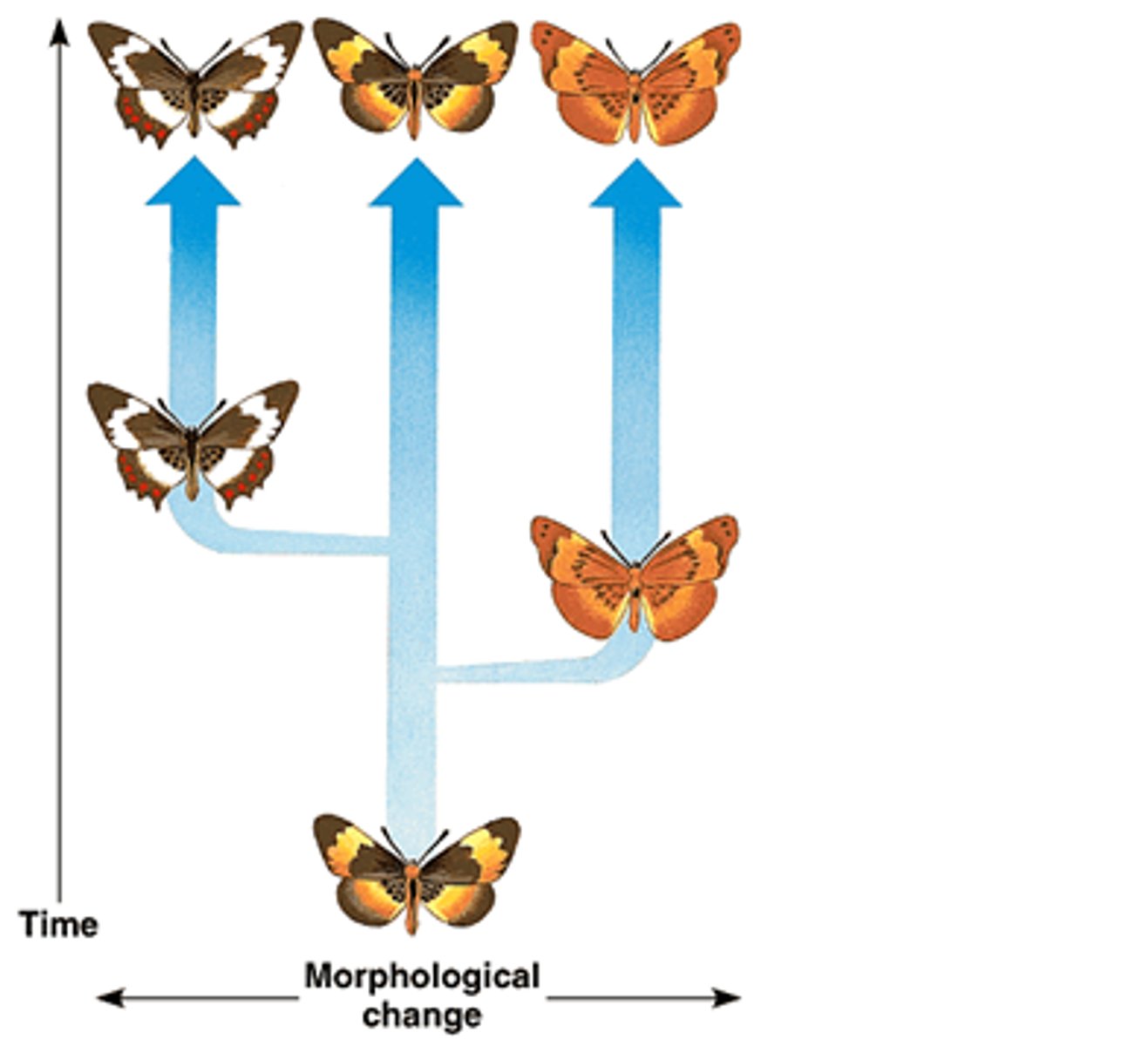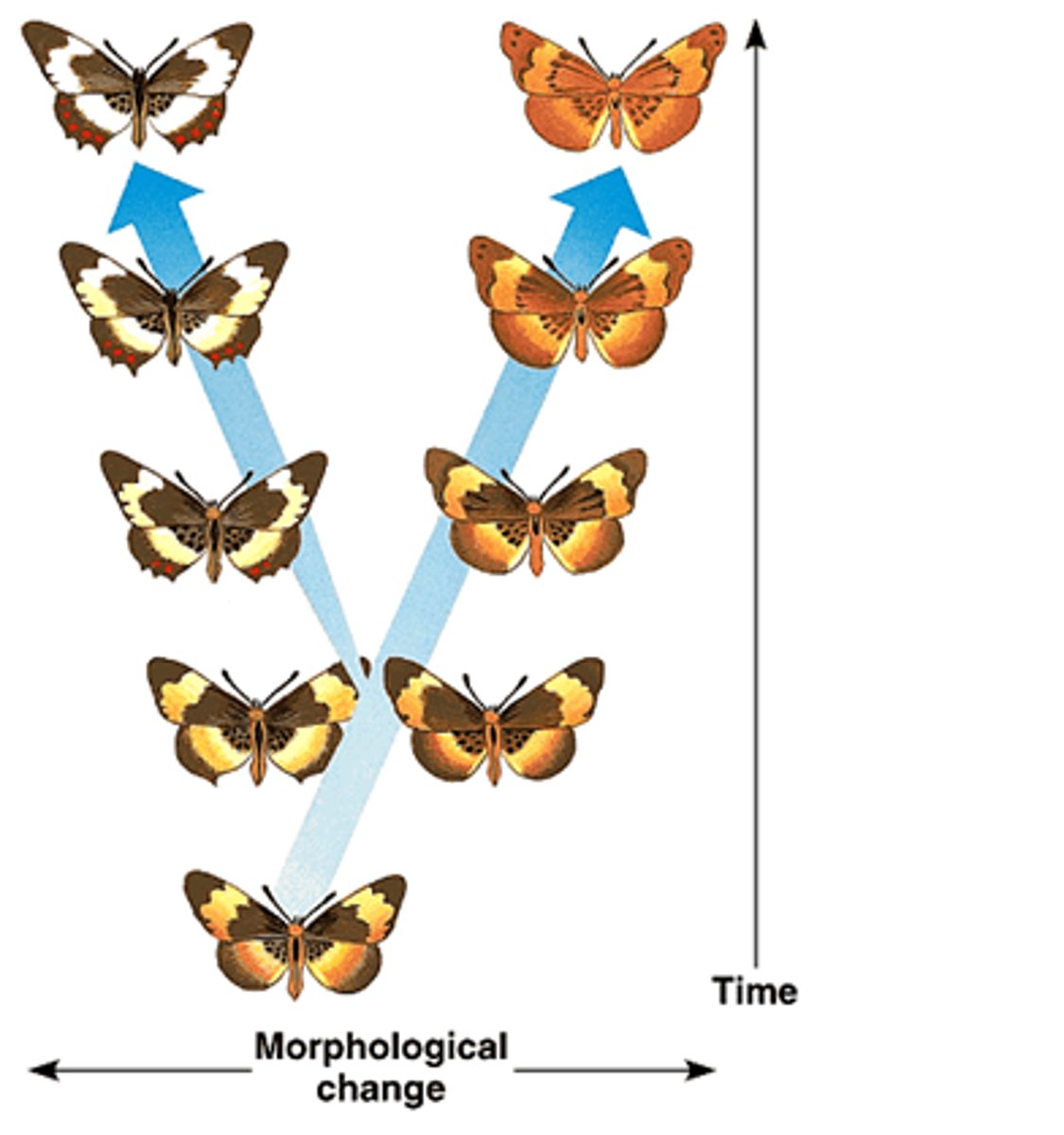AP Biology: Unit 7 Natural Selection (Chapters 19~22) - Majoros
1/75
There's no tags or description
Looks like no tags are added yet.
Name | Mastery | Learn | Test | Matching | Spaced |
|---|
No study sessions yet.
76 Terms
Speciation
The origin of new species
Macroevolution
Broad patterns of evolutionary change above the species level
Biological Species Concept
A group of populations whose members have the potential to interbreed in nature and produce viable,
fertile offspring
Reproductive isolation
Barriers impede two species from producing viable, fertile offspring
Hybrids
Offspring of crosses between different species
Prezygotic Barriers
Before sperm fertilizes egg
Habitat isolation
Two species encounter each other rarely, or not at all, because they occupy different habitats, even though not isolated by physical barriers
Temporal isolation
Species that breed at different times of the day, different seasons, or different years cannot mix their gametes
Behavioral isolation
Courtship rituals and other behaviors unique to a species are effective barriers
Mechanical isolation
Morphological differences can prevent successful mating
Gametic Isolation
Sperm of one species may not be able to fertilize eggs of another species
Postzygotic barriers
Inviability of offspring created after fertilization
Reduced hybrid viability
Fertilized eggs fail to develop
Reduced hybrid fertility
Even if hybrids are vigorous, they may be sterile
Hybrid breakdown
Some first-generation hybrids are fertile, but when they mate with another species or with either parent species, offspring of the next generation are feeble or sterile
Morphological Species Concept
Defines a species by structural features
Ecological Species Concept
Views a species in terms of its ecological niche
Phylogenetic species concept
Defines a species as the smallest group of individuals on a phylogenetic tree
Allopatric Speciation
Physical barrier separates a population; form of speciation
Sympatric Speciation
No barrier separates a population; form of speciation
Polyploidy
Possessing more than 2 sets of chromosomes; occurs most often in plants and decreases gene flow between polyploids and normal individuals
Punctuated Equilibrium
Periods of apparent stasis interrupted by sudden change; supported by fossil evidence

Gradualism
Slow, steady change of organisms to new species

population
The evolutionary impact of natural selection is only apparent in the changes in a _______ over time
microevolution
a change in allele frequencies in a population over generations
genetic variation
differences among individuals in the composition of their genes or other DNA segments
sources for genetic variation
-formation of new alleles
-altering gene number or position
-rapid reproduction
-sexual reproduction
mutation
a change in the nucleotide sequence of an organism's DNA
population
a group of individuals of the same species that live in the same area and interbreed, producing fertile offspring
gene pool
consists of all copies of every type of allele at every locus in all members of the population
p
the frequency of the C^R allele in the gene pool of this population
q
the frequency of the C^W allele in the gene pool of this population
Hardy-Weinberg Principle
this principle states that the frequencies of alleles and genotypes in a population will remain constant from generation to generation, provided that only Mendelian segregation and recombination of alleles are at work
Equilibrium
a gene pool is in Hardy-Weinberg _____
Hardy Weinberg proportion
p^2 + 2pq + q^2 = 1
Conditions for Hardy Weinberg Equilibrium
1. No mutations
2. Random mating
3. No natural selection
4. Extremely large population size
5. No gene flow
adaptive evolution
evolution that results in a better match between organisms and their environment
genetic drift
A change in the allele frequency of a population as a result of chance events rather than natural selection
founder effect
when a few individuals become isolated from a larger population, this smaller group may establish a new population whose gene pool differs from the source population
bottleneck effect
Genetic drift resulting from the reduction of a population, typically by a natural disaster, such that the surviving population is no longer genetically representative of the original population
Significant points about Genetic Drift
1. Genetic drift is significant in small populations
2. Genetic drift can cause allele frequencies to change at random
3. Genetic drift can lead to a loss of genetic variation within populations
4. Genetic drift can cause harmful alleles to become fixed
gene flow
the transfer of alleles into or out of a population due to the movement of fertile individuals or their gametes
natural selection
_____ is not random, and consistently increases the frequencies of alleles that provide reproductive advantage and thus leads to adaptive evolution
sexual dimorphism
a difference between the two sexes in secondary sexual characteristics
ex: diff in size, color, ornamentation, and behavior
heterozygote advantage
Greater reproductive success of heterozygous individuals compared to homozygotes; tends to preserve variation in gene pools
defined in terms of genotype NOT phenotype
adaptation
Inherited characteristic of an organism that enhances its survival and reproduction in a specific environment.
analogous
Having characteristics that are similar because of convergent evolution, not homology.
artificial selection
The selective breeding of domesticated plants and animals to encourage the occurrence of desirable traits.
biogeography
The scientific study of the past and present geographic distributions of species
convergent evolution
The evolution of similar features in independent evolutionary lineages.
evolution
Descent with modification; the idea that living species are descendants of ancestral species that were different from the present-day ones; also defined more narrowly as the change in the genetic composition of a population from generation to generation.
evolutionary tree
A branching diagram that reflects a hypothesis about evolutionary relationships among groups of organisms.
fossil
A preserved remnant or impression of an organism that lived in the past.
homologous structures
Structures in different species that are similar because of common ancestry.
homology
Similarity in characteristics resulting from a shared ancestry.
natural selection
A process in which individuals that have certain inherited traits tend to survive and reproduce at higher rates than other individuals because of those traits.
Pangaea
The supercontinent that formed near the end of the Paleozoic era, when plate movements brought all the landmasses of Earth together.
vestigial structure
A feature of an organism that is a historical remnant of a structure that served a function in the organism's ancestors.
Phylogeny
The evolutionary history of a species or group of species.
Taxonomy
How organisms are named and classified
Binomial
Two-part format of the scientific name that was instituted in the 18th century by Carolus Linnaeus
Genus
Group to which the species belongs, also the first part of a binomial
Taxon
a named taxonomic unit at any given level in the hierarchy
Phylogenetic tree
A branching diagram representing the evolutionary history of a group of organisms
Branch point
Represents the common ancestor of the two evolutionary lineages diverging from it
Sister taxa
Groups of organisms that share an immediate common ancestor that is not shared by any other group
Rooted
A branch point within the phylogenetic tree represents the most recent common ancestor of all taxa in the tree
Homologies
phenotypic and genetic similarities due to shared ancestry
Analogy
similarity between organisms that is due to convergent evolution
Clades
Groups which include an ancestral species and all of its descendants
Monophyletic
Consists of an ancestral species and all of its descendants
Paraphyletic
Group which consists of an ancestral species and some, but not all, of its descendants
Polyphyletic
Group which includes distantly related species but does not include the most recent common ancestor
Shared ancestral character
A character that originated in an ancestor of the taxon
Outgroup
a species or group of species from an evolutionary lineage that is closely related to but not part of the group of species we are studying
Maximum parsimony
We should first investigate the simplest explanation that is consistent with the facts